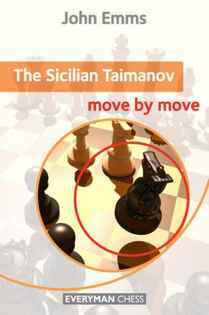Sicilian Taimanov, Move by Move, The
John Emms

The Taimanov variation of the Sicilian, introduced by the opening moves 1.e4 c5 2.Nf3 e6 3.d4 cxd4 4.Nxd4 Nc6 or 1.e4 c5 2.Nf3 Nc6 3.d4 cxd4 4.Nxd4 e6, is one of the most flexible variations in the Sicilian. What other opening system sees Blacks king bishop routinely developed at …e7, …d6, …c5 or …b4? Never as popular or heavily analyzed as the Najdorf, Sveshnikov or Dragon variations, the Taimanov is nonetheless considered quite sound and reliable.
Unlike other lines of the Sicilian, the Taimanov has never had a lot of literature devoted to it. Delchev and Semkovs The Safest Sicilian, first published in 2006 and later revised in 2008, is a first rate repertoire book and James Rizzitanos Chess Explained: The Sicilian Taimanov (also published in 2006) a useful introduction. The latest work on the subject, The Sicilian Taimanov: Move by Move by John Emms is both a repertoire book and an instructional manual plus more up to date.
The material covered in this book is as follows:
Note the reviewer has slightly altered the layout of the index of variations to emphasize both the depth of coverage and to clarify what main lines are covered. The Taimanov has different interpretations and followers of lines where Black develops his king knight at e7, for example, will not find their line included.
White Plays Be2
1 e4 c5 2 Nf3 e6 3 d4 cxd4 4 Nxd4 Nc6 5 Nc3 Qc7 6 Be2
6 Be3 a6 7 Be2 main line
6…a6 7 0-0
7 Be3 Nf6
8 a3!? 102
8 0-0 main line
7…Nf6 8 Be3
8 Kh1 76
8 Bg5 89
8 a3 93
8 Nxc6 93
8…Bb4 9 Na4
9 f3 13
9 Bf3 13
9 Bd3 13
9 Nxc6 21, 36
9…Be7
9…0-0 27
9…b5 27
9…Bd6 27
10 Nxc6
10 c4 Nxe4 27
10…bxc6 11 Nb6
11 Bd3 36
11…Rb8 12 Nxc8 Qxc8 13 Bd4
13 e5 44
13…c5 56
13…Nxe4 66
13…Qc7 66
White Plays Be3 and Bd3
1 e4 c5 2 Nf3 e6 3 d4 cxd4 4 Nxd4 Nc6 5 Nc3 Qc7 6 Be3 a6 7 Bd3 b5
7…Nf6 8 0-0 b5 9 Nxc6 Qxc6 138, 147
8 Nxc6
8 0-0 Bb7
9 Kh1 114
9 Qe2 121
8…Qxc6 9 0-0
9 e5 147
9…Bb7 10 a3
10 Kh1 147
10 Re1 147
10…Nf6 11 Qe2
11 Re1 129
11 Qf3 129
11…Be7 138
11…h5 129
The English Attack
1 e4 c5 2 Nf3 e6 3 d4 cxd4 4 Nxd4 Nc6 5 Nc3 Qc7 6 Be3 a6 7 Qd2 Nf6
7…b5 154
8 0-0-0
8 f3 207
8…Be7
8…Bb4 154
9…0-0
9…b5 157
9…h5
10 Qf2 189
10 Kb1 189
10 Nxc6 198
10 g4 b5 11 g5
11 h4 182
11…Nh5
11…Ne8 157
12 Nce2
12 Nxc6 165
12 Kb1 174
12…Rd8
12…Nxd4 157
13 Ng3 165
13 Kb1 174
White Plays 6 f4
1 e4 c5 2 Nf3 e6 3 d4 cxd4 4 Nxd4 Nc6 5 Nc3 Qc7 6 f4 a6 7 Nxc6
7 Be2 217
7 Be3 228
7 Nf3 243
7…Qxc6 8 Bd3 b5 9 Qe2 Bb7
10 0-0 236
10 Bd2 243
The Fianchetto Variation
1 e4 c5 2 Nf3 e6 3 d4 cxd4 4 Nxd4 Nc6 5 Nc3 Qc7 6 g3 a6 7 Bg2 Nf6
7…b5 253
8 0-0
8 Be3 272
8 Nb3 272
8…Nxd4
8…Be7 253
8…Bc5 253
9 Qxd4 Bc5 10 Bf4
10 Qd3 272
10…d6 11 Qd2
11 Qd3 253
11…h6 12 Rad1 e5 13 Be3 Be6 14 Bxc5 dxc5
15 f4 264
15 Qd6 264
15 Nd5 272
White Plays 5 Nb5
1 e4 c5 2 Nf3 e6 3 d4 cxd4 4 Nxd4 Nc6 5 Nb5 d6 6 c4
6 Bf4 e5 7 Be3 (7 Bg5 283) 7…Nf6 8 Bg5 Be6
9 N1c3 283
9 Bxf6 291
9 Nd2 291
7 N1c3 a6 8 Na3
8 Nd4 298
8…b6
8…Be7 298, 312
8…d5 298
9 Be2 Bb7 10 0-0 Be7 11 Be3 Ne5
11…0-0 298
12 f3 298
12 f4 312
Other Lines
1 e4 c5 2 Nf3 e6
or 2…Nc6 356
3 d4 cxd4 4 Nxd4 Nc6 5 Nc3
5 c4 323
5 Nxc6 332
5 Be3 346
5 Be2 346
5 g3 346
5…Qc7
6 Nxc6 340
6 Ndb5 356
The material in this book is organized around 39 model games. The author uses the Everyman Move by Move series format of asking many questions throughout this work to reinforce the lessons being taught. The proposed repertoire has flexibility built into it to allow variety, provide options in certain tournament situations and offer reserve systems in case a primary line needs to be repaired. One example is after 1 e4 c5 2 Nf3 e6 3 d4 cxd4 4 Nxd4 Nc6 5 Nc3 Qc7 6 Be2 a6 7 0-0 Nf6 8 Be3 Bb4 9 Na4 Be7 10.Nxc6 bxc6 11 Nb6 Rb8 12 Nxc8 Qxc8 13 Bd4, not only 13 …c5 but also 13… Nxe4 and 13… Qc7 are examined.
The Sicilian Taimanov: Move by Move covers the theoretical state of this opening at a level that will be useful for titled players but what makes it especially helpful for a wide audience is the author’s clear and thoughtful prose that carefully explains the ins and outs of this rich system. One example can be found on page 237 where Emms makes comprehensible when Black should answer Whites Nxc6 with …Qxc6 or …bxc6 that it depends in part on whether Black has played …a6 and where Whites bishops have been developed to (a bishop on d3 makes …Qxc6 more logical while on e2 it doesn’t guard d3 and makes a future …d5 more attractive).
This sort of helpful advice is gold for all but especially for the target audience for this book which is 1800 to 2400. Throughout this work Emms does a very nice job of merging the theoretical nitty-gritty with the question and answer format which makes the material much more accessible.
Highly Recommended
